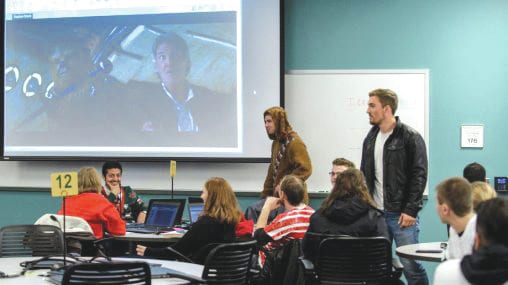
FAIRBORN — Batman, Robin, James Bond, Han Solo and Chewbacca the Wookiee were all there. And they brought their vehicles with them.
Well, not exactly. It was the final project in the fall semester introductory materials science and engineering class for sophomores on applying classroom knowledge to a make-believe world.
The 60 students were assigned to conduct an engineering analysis of materials used in the structure, propulsion systems and weaponry in fictional vehicles such as those in James Bond, “Star Wars” and “Star Trek” movies as well as video games. The students had to then determine how they would manufacture such a vehicle in the real world.
“The course itself is conducted in an active-learning environment. The students do a lot of reading and research on their own, come to class and do problems in groups,” said Raghavan Srinivasan, professor and director of the Materials Science and Engineering program in the College of Engineering and Computer Science. “It made them think outside the box. Some of them went overboard, and they all had a lot of fun doing it.”
The project counted as 20 percent of the students’ grades, with extra credit for appearing in costume.
The team presenting on the Millennium Falcon from the “Star Wars” movies started with members dressed as Han Solo and Chewbacca striding into class with John Williams’ theme music playing in the background and ended with the iconic scrolling text.
Students garbed as Batman and Robin helped present on The Tumbler, a Batmobile featured in “The Dark Knight” movies. The team did an analysis of materials that would withstand bullets and be able to crash through concrete barriers.
“The Tumbler also has a landing hook because — you know — why not?” one student presenter quipped.
The Lotus Esprit (Wet Willie) from the James Bond movie “The Spy Who Loved Me” featured a student presenter looking very Bond-like, with a snappy charcoal suit and bowtie.
The fictional Lotus was also a submarine, and the team used mathematical equations to calculate the water pressures the car would be subjected to.
Another group presented on James Bond’s Aston Martin DB5. The vehicle was based on an actual car, with the 1965 model selling for $5 million. One of the student presenters told the class the price tag prohibited the team from bringing one of the cars to class.
“You’re just going to have to be impressed with our pictures,” he deadpanned.
The team suggested tungsten or Inconel alloy be used in the manufacture of the Aston Martin’s tire slashers, jagged spinning cylinders that flare out from the wheels to disable enemy vehicles.
The team presenting the Landmaster vehicle from the “Star Fox” video game said the materials must be strong, heat resistant and not too heavy for the vehicle to be able to hover. The students recommended a high-strength, low-alloy frame that would be corrosion resistant in its environment. The vehicle’s armor would be a titanium-ceramic composite.
The M35 Mako land rover from the video game “Mass Effect Universe” should have Kevlar and carbon fiber for its frame, “run-flat” tires with a honeycomb design and a polycarbonate bulletproof glass, the students said.
The team presenting the USS Enterprise from the “Star Trek” movies said the fictional vehicle is made of Tritanium, which is 20 times harder than diamonds but doesn’t exist. However, the students said it may be possible to synthesize diamonds into a Tritanium-like matrix.
One of the presenters on the DeLorean DMC-12 used in the “Back to the Future” movies asked the class who had seen the movies, which were released between 1985 and 1990 — way before most of them were born. Several students admitted they had not.
“You need to get a life,” he joked. “Go home and watch the movies.”
The fictional car is a time machine that disappears into a wormhole once it exceeds 88 miles an hour. It features a “flux capacitor” to control flux energy, enabling effective time travel, and a nuclear reactor for power. The team determined that it is currently not possible to build a nuclear reactor small enough to fit into the DeLorean.
Srinivasan, who is teaching the course again this spring semester, said the class is a fun way to learn and to learn how to learn.
“The main thing is that students should realize learning doesn’t stop at the end of class,” he said. “They’ve got to go outside of what they’ve learned in class. There is a lot of information out there. There is a lot of learning they can do on their own and will have to do the rest of their lives.”


